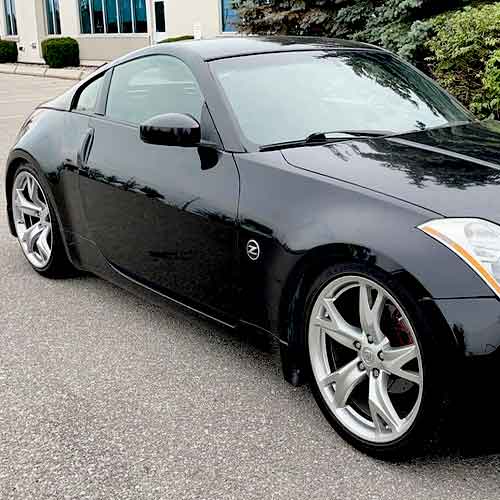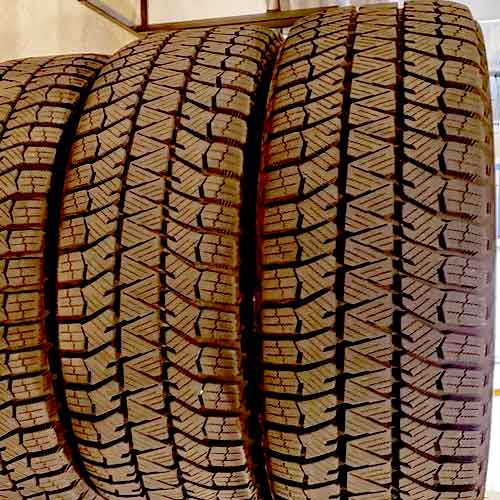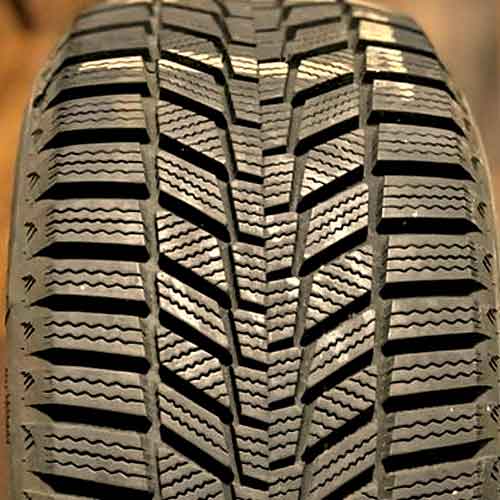Out of both tires, the Continental WinterContact SI features a commendable traction on snow, though the tire lacks to its counterpart, the Bridgestone Blizzak WS90, when it comes to ice. Let’s see why, along with how these tires do in other areas. Though first, let’s look at the tire sizes and their designs.

Table of Contents
Available Sizes
The Continental WinterContact SI comes in 15 to 20″ with following.
- Speed ratings: H and T.
- Load ratings: XL only.
- Tread depth: 10/32″ on all.
- Weight: 15 to 36 lbs.
On the other hand, the Bridgestone Blizzak WS90 offers 52 total sizes in 15 to 19 inches rims. They come with following specs.
- Speed ratings: T or H.
- Load ratings: SL or XL.
- Tread depth: 11 or 12/32″.
- Weight: 17 to 29 lbs.
- Tread warranty: None.
Tread Design
The Blizzak WS90 (review) is a marvel in tire technology, when it comes to winter performance. Let’s consider its tread pattern closely.

So you get an intricate directional tread pattern here.
Where 3 prominent ribs are featured, with the central rib forming a continuous band.
This rib comes with a combination of wave-like and rectilinear sipes.
And apart from that you also see in-groove notches connected with V shaped ones (facing in both lateral directions).
Moving towards shoulders, the lugs are also equipped with a lot of biters.
You see notches facing central lugs, a long with longitudinal incisions of varying widths (which seem to be dividing these blocks up).
Moreover, you also get a combination of zigzag longitudinal sipes at the end there. Though most of the siping is interlocking just like seen in the middle.
On the other hand, Continental WinterContact SI comes with a very unique pattern as well.

You see a directional design here, where central most area consist of a continuous running rib made up with unaligned blocks (which resemble leaves on a wine, leaves being blocks).
These lugs have chamfered edges, and full depth interlocking sipes.
The surrounding lugs also showcase similar tread features, though they are bigger and their siping (pattern) have different angles to them (which enhances overall bite).
All these lugs form 3 ribs in total, which also make 4 longitudinal grooves as well, (interconnected by slanted lateral tread voids, allowing for excellent tread cleaning capabilities).
The shoulder lugs are elongated and have wider later gaps in between though. So these lugs make longer siping pattern as well (though having similar wave-like pattern).
And yes, one more thing, unlike central blocks, shoulder blocks’ sharper edges are not chamfered.
Ice Traction
When it comes to icy surfaces, the Bridgestone Blizzak WS90 confidently asserts its dominance, outperforming the Continental WinterContact SI by stopping a whole second quicker on average, which by the way, is also the case when it comes to acceleration (up to 40 mph).
So why is Continental lacking here?
Well, because the tire is missing with expertly designed biters as you see on its competitor.
The tire is characterized by larger tread voids and fewer notches, seems less prepared for icy conditions. And its central tread area, crucial for effective braking, struggles to maintain an adequate grip on packed ice due to the tire’s wider lateral tread voids.
Moreover, the tire also is lacking features such as multi-angled siping, which further detracts from its performance.
And yes, this deficiency extends to ice handling too, where the scarcity of notches leads to longer handling times.
The Blizzak WS90 on the other side, offers superior biters. Its central rib consists of a variety of slanted cuts, V-shaped notches in both lateral directions, and an abundance of siping, all adding up to outstanding ice-biting performance.
The dual-angle design of these biters further enhances the grip, thus facilitating efficient braking. When it comes to handling, the tire’s shoulder lugs are key and they come equipped with biters facing both laterally and longitudinally, providing a comprehensive grip from every possible angle.
So Ice Traction is better on Bridgestone WS90.
Dry Performance
Dry grip is determined by the extent of the rubber’s contact with the surface, and two key components are at play here, namely, directional grip and lateral traction.
Let’s check them all out.
Directional Grip
The efficiency of the directional grip is determined by the central tread area (configuring how much rubber to road contact is made from there).
This is because when a tire rolls straight, this middle area gets the most weight concentration on itself.
And Blizzak WS90 with its continuous running rib, ensures continuous surface contact as the tire moves straight, resulting in superior performance.
In comparison, although the WinterContact SI also features a almost continuous running layer there, it’s not as streamlined as it’s counterpart, hence you see almost 9 feet longer braking distance here.
So overall, one can easily conclude Blizzak to be a better choice here.
Handling
Handling is dependent on the tire’s shoulder areas and overall weight. Let me explain why that’s the case.
So like the directional travel puts pressure on the middle lugs, while cornering, the weight shifts towards shoulders (because of inertia), and how well those lugs connect with the road is much more significant.
That’s why the Blizzak WS90 with it’s closed up shoulder lugs offer better performance, relatively.
In this regard, the Continental WinterContact SI on the other hand, besides having wider grooves also feature a heavier structure.
This basically causes the tire’s lugs to flex more, leading to weakened steering feedback (and reduced balance between under and oversteering).
So you get superior handling on Blizzak WS90.
Snow Traction
In the snowy landscapes, both tires truly display their prowess with impressive performances, though still, the Continental WinterContact SI provides slightly better traction, particularly when it comes to fluffy snow.
The Bridgestone Blizzak WS90 basically comes with a more closed design with a continuous running rib in the middle (part of tread), and the tire lacks any kind of interlocking grooves. This configuration means its tread is not capable of snow collection, giving its competitor the advantage.
But why is that important? Well simply put, because snow sticks better on snow, compared to rubber.
Here, the Continental tire with its wider tread voids allow for better snow-to-snow contact, where its lug voids easily retain the fluffy snow particles within their interconnected grooves and snow-vices.
Moreover, its bolder directional pattern also provides you with paddling, scooping snow backwards and generating a far superior forward momentum, relatively.
So overall snow performance is better on Continental.
Comfort Levels
The overall ride comfort is two parts, noise and tire’s ability to absorb the shocks of the road.
Let’s start with the noise factor.
To put it simply, noise is created when air particles hit the walls of the tread, so this means, the larger the tread gaps, the noisier the tire would get.
This is why the Blizzak WS90, with its compact tread gaps, offers a better overall performance.
Moreover, the tire also features superior pitch sequencing technology. Its tread blocks vary in geometry a little bit, allowing for air particles hitting the walls, to create different tones, which later then cancel out each other.
The Continental WinterContact SI on the other side, does better in regard to dampening vibrations.
Its comparatively softer tread compound gives it a superior ability to absorb shocks, ensuring a more comfortable ride.
So its a tie between two tire giants.
Wet Traction
Wet traction is primarily driven by two elements: the tread pattern and the type of rubber compound used in the tire. These factors essentially determine the tire’s grip on wet surfaces and its capacity to resist hydroplaning.
I’ve talked about them both below.
Wet Grip
While both tires are fitted with significant siping, the Bridgestone Blizzak WS90 still manages to offer slightly better performance.
The tire features a more aggressive siping pattern with a combination of rectilinear and interlocking (siping) slits.
Moreover, you also get a ton of biters on its tread as well, which grip the wet surface more efficiently.
These features render this tire a little better overall in the gripping department.
Sipes basically work by expelling air out, and forming a vacuum, which then sucks water particles coming underneath.
And here the Continental WinterContact, with its less effective siping lacks overall to its counterpart.
Though the tire does better in the hydroplaning performance, which is also a key part of overall wet traction.
Hydroplaning resistance
Hydroplaning is another word for floating, because it happens when water starts to float with a thin layer of water forming between the tread and the road.
And its caused by in-effective dispersal of water form the grooves. So the wider the better.
That’s why the Continental WinterContact SI shows remarkable performance in this area. Its wide grooves and sweeping arms enable higher average speeds without hydroplaning, both in straight and curved aquaplaning tests.
Moreover, its connected up system of grooves effectively dispels water in all directions, providing excellent hydroplaning resistance.
So Aquaplaning is better on Continental’s tire.
Summing Up
So what did we learn here? Well A lot.
In case of snow, or should I say fluffy snow, the Continental WinterContact SI stands out with its distinct tread design. Though this very design doesn’t allow the tire to excel when it comes to ice, and wet conditions.
And yes, its wider grooves which although offer superior snow scooping, also puts the tire in the backseat when it comes to dry traction. Though the difference is very low here, between the two tires.
Other than this, both tires are rated as equals when it comes to comfort, as its two part, where one being noise, and the other one, being vibrations absorption capability.
Here the Continetal does better with the later, whereas the Bridgestone Blizzak WS90 is a superior pick when it comes to overall road quietness.